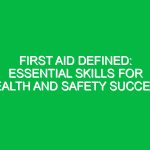Introduction
In the realm of Health, Safety, and Environment (HSE), the concept of personal protective clothing (PPC) stands as a cornerstone for safeguarding workers across various industries. Personal protective clothing refers to garments designed to protect individuals from potential hazards that could cause injuries, illnesses, or fatalities in the workplace. Whether it’s chemical spills, extreme temperatures, or mechanical risks, the right PPC can be the difference between safety and disaster. This guide aims to provide an in-depth exploration of personal protective clothing, its significance in HSE, and practical insights on its effective use.
Understanding Personal Protective Clothing
What Constitutes Personal Protective Clothing?
Personal protective clothing encompasses a wide range of garments and equipment designed to shield the wearer from specific hazards. The primary categories of PPC include:
- Head Protection: Helmets and hard hats designed to prevent head injuries from falling objects or electrical hazards.
- Eye and Face Protection: Safety goggles, face shields, and visors that guard against flying debris, chemical splashes, and radiation.
- Respiratory Protection: Masks and respirators that filter harmful substances from the air, protecting the lungs.
- Hearing Protection: Earplugs and earmuffs that reduce noise exposure in loud environments.
- Hand Protection: Gloves designed for various tasks, including chemical resistance, cut resistance, and thermal protection.
- Body Protection: Coveralls, aprons, and jackets that guard against chemicals, heat, and other environmental hazards.
- Foot Protection: Safety boots and shoes that prevent injuries from heavy objects, slips, and chemicals.
Each type of protective clothing serves a specific purpose aimed at reducing the risk of injury or exposure to hazardous conditions.
Importance of Personal Protective Clothing in HSE
The implementation of personal protective clothing is not merely a recommendation; it is often a legal requirement in many industries. The importance of PPC in HSE can be highlighted through several key points:
1. **Risk Mitigation:** Personal protective clothing significantly reduces the risk of injuries and illnesses caused by workplace hazards. By wearing appropriate PPC, workers can protect themselves from harmful exposure, whether from chemicals, physical agents, or environmental conditions.
2. **Compliance and Legal Standards:** Various regulations, such as the Occupational Safety and Health Administration (OSHA) standards in the United States, mandate the use of personal protective clothing in specific industries. Non-compliance can lead to legal repercussions and hefty fines for organizations.
3. **Enhanced Productivity:** A safe working environment fosters productivity. When workers feel secure in their protective gear, they can focus on their tasks without the fear of injury.
4. **Promoting a Safety Culture:** The visible use of personal protective clothing promotes a culture of safety within organizations. It encourages all employees to prioritize safety measures and take responsibility for their wellbeing.
Components and Types of Personal Protective Clothing
Detailed Overview of Key Components
When discussing personal protective clothing, it’s crucial to delve into the various components that make up an effective PPC system. Each component plays a vital role, and selecting the right type is essential for optimal protection.
Head Protection
Head protection is critical in environments where there is a risk of falling objects or electrical hazards. Hard hats are the most common form of head protection, designed to absorb impact and provide insulation from electrical shocks. When selecting a hard hat, consider the specific hazards present in the work environment, including the type of materials and potential electrical risks.
Eye and Face Protection
The eyes and face are particularly vulnerable to injury from flying debris, chemicals, and radiation. Safety goggles and face shields are essential in laboratories and construction sites. When choosing eye protection, ensure that the equipment meets the appropriate safety standards and is suitable for the specific task at hand.
Respiratory Protection
Respirators are crucial for workers exposed to harmful airborne substances, including dust, fumes, and chemicals. Different types of respirators are available, including N95 masks and full-face respirators. Understanding the types of hazards present will help determine the appropriate level of respiratory protection required.
Hand Protection
Gloves are one of the most versatile pieces of personal protective clothing. They come in various materials, including rubber, latex, leather, and Kevlar, each designed for specific tasks such as chemical handling, heat resistance, or cut protection. It is vital to assess the specific risks and choose gloves that offer adequate protection without sacrificing dexterity.
Body Protection
Body protection includes coveralls, aprons, and jackets designed to shield the body from chemicals, heat, and other dangers. The choice of body protection depends largely on the nature of the work and the potential hazards involved. High-visibility clothing is also a category of body protection, crucial in environments where visibility is a concern.
Foot Protection
Foot protection is essential in industries where heavy equipment is used. Safety boots with steel toes, slip-resistant soles, and puncture-resistant materials can prevent serious injuries. When selecting footwear, consider the specific risks associated with the work environment, such as chemical exposure or electrical hazards.
Best Practices for Using Personal Protective Clothing
Implementing Effective Use of PPC
To maximize the effectiveness of personal protective clothing, organizations and workers must adhere to best practices throughout the selection, maintenance, and use phases. Here are some actionable insights:
- Conduct Hazard Assessments: Before selecting personal protective clothing, perform a thorough hazard assessment of the work environment. Identify potential risks and choose appropriate PPC accordingly.
- Training and Education: Provide training for all employees on the correct use and maintenance of personal protective clothing. Understanding the importance of PPC can increase compliance and safety.
- Regular Inspections: Regularly inspect personal protective clothing for signs of wear and tear. Damaged PPE should be replaced immediately to ensure continued protection.
- Encourage Reporting: Foster an environment where employees feel comfortable reporting issues with their personal protective clothing. Open communication can lead to improvements in safety practices.
- Stay Updated on Regulations: Keep abreast of changes in safety regulations and standards regarding personal protective clothing. This ensures compliance and best practices are maintained.
Potential Hazards and Risks
Understanding the Risks Associated with Inadequate Protection
While personal protective clothing is designed to minimize risks, inadequate or improper use can expose workers to significant hazards. Some potential risks include:
1. **Chemical Burns:** Without appropriate chemical-resistant gloves or clothing, workers may face burns from hazardous substances.
2. **Injury from Falling Objects:** Failure to wear head protection in environments with overhead risks can lead to life-threatening injuries.
3. **Respiratory Illnesses:** Neglecting to use the proper respiratory protection can result in long-term health issues due to inhalation of harmful particles or gases.
4. **Slips and Falls:** Not utilizing slip-resistant footwear can increase the likelihood of accidents in wet or oily conditions.
5. **Electrical Shock:** Inadequate protection can lead to severe injuries or fatalities from electrical hazards.
Understanding these risks emphasizes the critical importance of selecting, wearing, and maintaining personal protective clothing appropriately.
Regulations and Standards
Legal Framework Governing Personal Protective Clothing
In many jurisdictions, personal protective clothing is governed by specific regulations and standards that outline requirements for workplace safety. In the United States, OSHA has set forth guidelines that require employers to provide appropriate PPE to employees based on workplace hazards. Key regulations include:
- OSHA 29 CFR 1910: This section outlines general industry standards, including those related to personal protective equipment.
- ANSI/ISEA 105: This standard provides guidelines for the performance and testing of protective gloves.
- NIOSH Respirator Certification: National Institute for Occupational Safety and Health (NIOSH) sets standards for respiratory protection, ensuring that respirators meet specific safety criteria.
Compliance with these regulations is crucial for organizations to avoid penalties and ensure the safety of their workforce.
Conclusion
In conclusion, personal protective clothing serves as a fundamental aspect of health, safety, and environmental practices within the workplace. Its role in preventing injuries, complying with legal requirements, and fostering a culture of safety cannot be overstated. By understanding the various components of personal protective clothing, adhering to best practices, and staying informed about regulations, organizations can create a safer working environment. Ultimately, the responsible use of personal protective clothing is not just about compliance; it is about protecting lives and promoting overall health and safety in the workplace. As industries evolve, continuous improvement in the selection and use of personal protective clothing will remain essential in ensuring worker safety and wellbeing.


